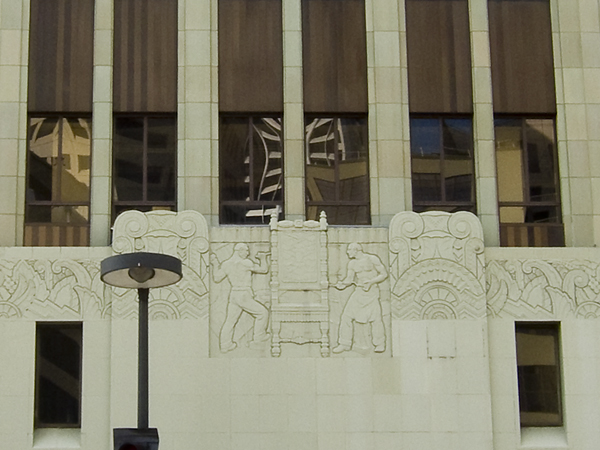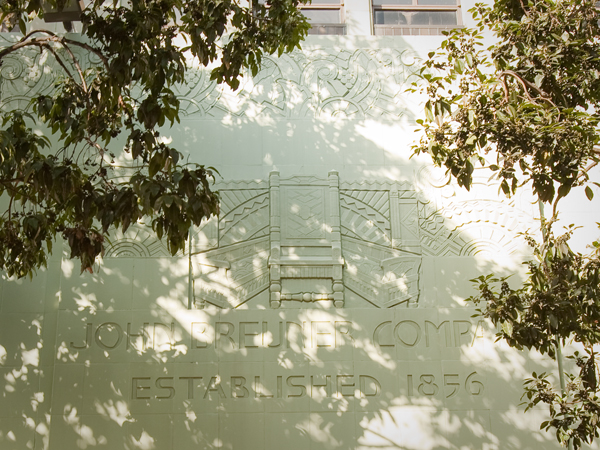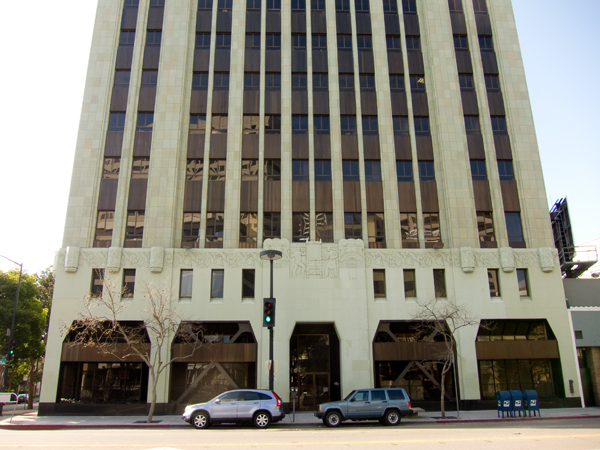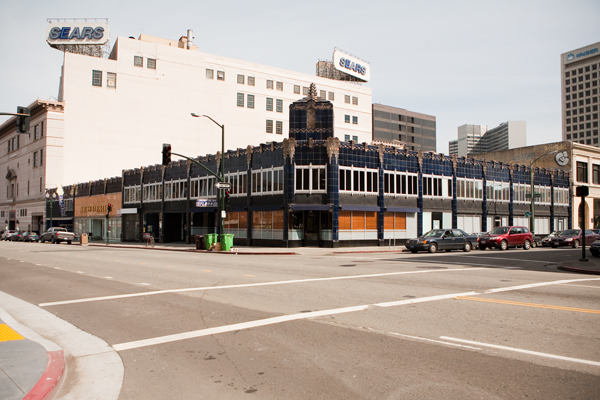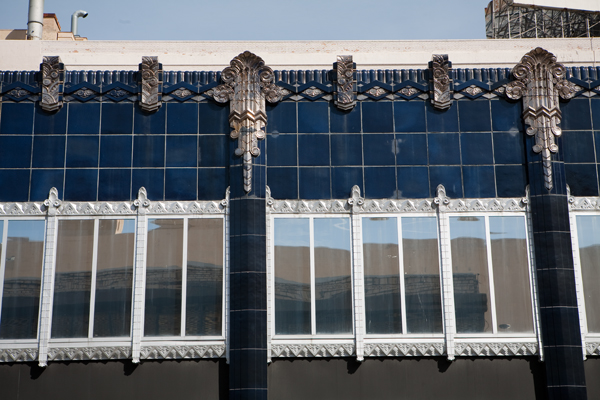Stumped?
(I bet you didn’t even know Baghdadian was a word… I didn’t!)
These are just a handful of the architectural influences of our majestic and recently refurbished Fox Theater. I’m kicking off my Art Deco series with the Fox despite its lack of Deco authenticity (we’ll get to more of what that means next week), because frankly, it’s kind of a big deal. And here’s why…
On Sept. 21, 1926 the Oakland Tribune reported “Oakland is to have two new motion picture theaters in the downtown district increasing the assessed valuation of the city by four million dollars or more…” The first of these was The Fox.

Historical Photo circa 1928 (courtesy Dreyfus Report, 2001)
Originally called the Oakland Theater (or West Coast Oakland Theater) upon opening in 1928, the name was later changed to the Fox Oakland Theater, and at the time it was said to be the largest theater complex on the West Coast, with a capacity of between 3200 and 3800. This was the heyday of large movie “palaces,” dripping with atmosphere and ambiance designed to transport audiences to romantic and exciting distant worlds. “Persian gardens, Italian palazzos and Egyptian courts rose in cities throughout the country offering patrons an exotic afternoon or evening of entertainment.” (Dreyfus Report, 2001)
The architects of the Fox followed suit, drawing influences from a number of exotic cultures, most prominently Indian and Middle Eastern. In fact, the overall structure of the building, with its central high dome, resembles a typical Brahmanian temple of Northern India, and the interior auditorium space is flanked by two enormous sculptures of Hindu Gods. The entire theater was constructed to convey a lavish lifestyle, opulent with exotic woods, richly textured fabrics, jeweled light fixtures, intricate tile and plaster work, and highly decorative metal finishes.
Moorish architecture is “a term used to describe the articulated Islamic architecture which developed in North Africa and south-western Europe.” (Wikipedia) This influence is seen in the parapet (elevated wall) connecting the two primary pylons comprising the main facade of the building, as well as the continuing roof-line of the main commercial wings of the building, with its repeating pattern of terra cotta ornamentation, and distinctive key-hole windows (see below).

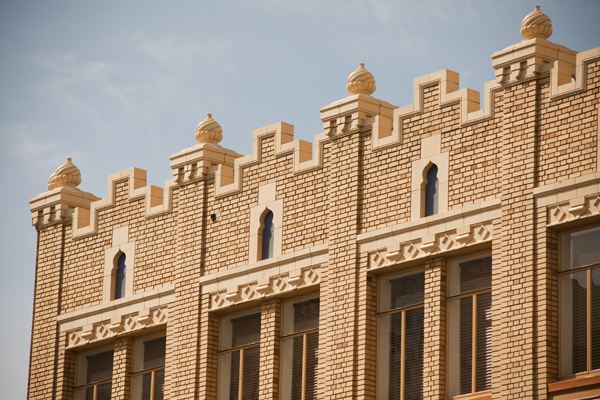
The medieval influence can be seen in the gargoyles perched atop the primary pylons (below, right).

And I’m not quite sure how the Baghdadian comes into play, other than the initial plans to call the theater “The Baghdad,” before settling upon the eponymous “Oakland Theater” instead.
So where’s the Art Deco you might ask?
Well… to be honest, there’s not a whole lot. But there is a bit, much of which was added during modernizing renovations in 1945. “The front façade and interior walls [were] covered with stainless steel sheathing in an art deco style zigzag pattern. The columns [were] sheathed in a streamlined stainless steel shape and the ticket booth replaced with a new one in the art deco style. The original tile floor [was] replaced with terrazzo, and the ceilings replaced by a stepped plaster ceiling in a cloud pattern, with neon accents… While these alterations represent fine examples of the art deco style, they resulted in the loss of a substantial amount of very significant historic material, and are inconsistent with the architectural character of the theater.” (Dreyfus Report, 2001)

The marquee was also updated to a more modern art deco style, but was done 10 years prior and is, hence, considered to be a “contributing historic” element. Here’s a shot of the original marquee followed by its replacement in 1935 (now refurbished).

Original Marqee circa 1929 (courtesy Dreyfus report, 2001)


The Fox was a premiere entertainment destination for decades, but suffered a decline in attendance in the 1960’s, as did many of the grand movie palaces throughout the country, due largely to the increasing popularity of television and the trend toward smaller multiplex theaters. The Fox tried several options including showing soft-core porn movies such as “Paradisio,” but eventually closed its doors in 1965, opening only sporadically for films and events during the next seven years.
“The Fox survived an arson fire in 1973, but its increasingly shabby condition led it to be derided as ‘the largest outdoor urinal in the world.‘” Still, the theater avoided being turned into a parking lot in 1975, unlike its sister Fox Theater in San Francisco, leveled in 1963 to make way for eventual replacement by high-rise offices and apartments. And thanks to the efforts of Oakland Mayor Lionel J. Wilson, the Fox Oakland achieved city landmark status in 1978.
And then it sat. And sat. And sat. It changed hands a few times and saw a few sporadic performances, but for the most part it simply sat… and continued to deteriorate. The City of Oakland purchased it in 1996 for $3 million dollars. In 1998 an Oakland Tribune editorial declared “the only life in the theater almost two years [after the City’s acquisition] is a crop of mushrooms sprouting from the theater’s soggy carpet.”
Then things started to happen. In 1999, the city spent $1 million to repair the roofs. At the same time, a sub-committee of the Oakland Heritage Alliance was formed, Friends of the Oakland Fox. Their goal: the historic preservation of the Fox Oakland Theater, and its use as a live entertainment venue. The Friends convinced the city to spend more money to restore the marquee and vertical blade sign to generate public interest in the renovation plans. And finally, architectural consultants Hardy Holzman Pfeiffer Associates were contracted to prepare a master plan for the Fox, generating two proposals that were both ultimately deemed undoable.
This is when Phil Tagami stepped in. He is the man who spoke before thousands at last year’s Uptown Unveiled block party to celebrate the re-opening of the Fox and the revitalization of Uptown. He is the hero of this story, the man who ultimately achieved what many said couldn’t be done. And can you guess what he did? Of course you can. The man raised money. And a lot of it. With a background in construction and prior experience restoring old buildings (including Kahn’s department store across from City Hall), he fashioned together a complex funding plan from various sources: private donations, city redevelopment money, grants, federal historic tax credits, large equity investments, and more.
An Oakland native, Tagami essentially donated thousands of hours of his personal time… his gift to the city, where he still lives with his wife and two children. Thank you Phil Tagami! We owe you a huge debt of gratitude.
And thanks as well to the City of Oakland, Friends of the Oakland Fox, and all those involved in this historic project.
The Fox Oakland Theater reopened on February 5th, 2009. Shows are currently booked by Another Planet Entertainment, the same folks who bring wonderful eclectic shows to the Independent in San Francisco. If you haven’t yet seen a show at the Fox, it’s high-time you high-tailed it to Uptown Oakland to check out this incredible gem!


